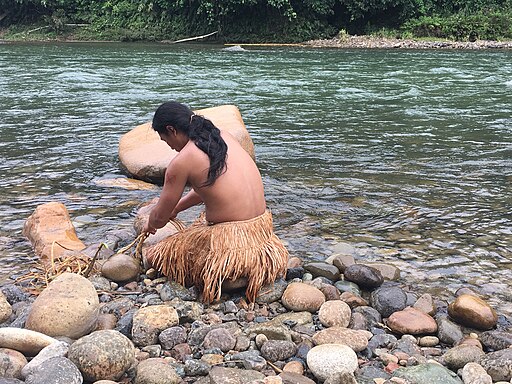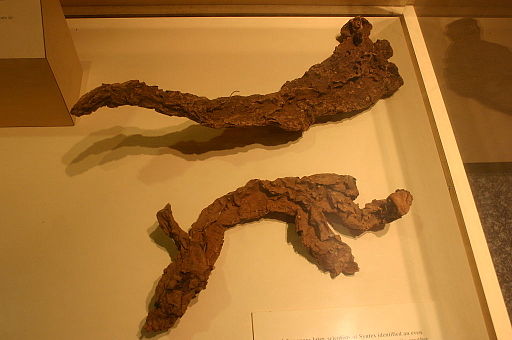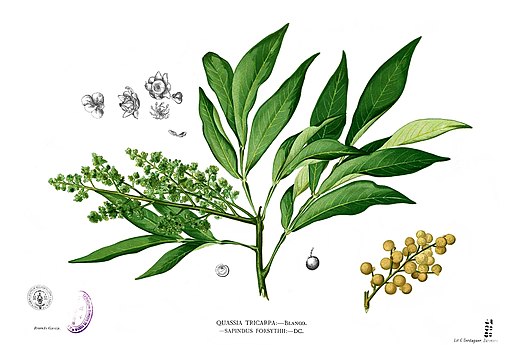
A variety of poisonous plant species traditionally used by Native Americans for fishing and as a sedative are known by the common name of barbasco . Some of these species, such as Dioscorea bartlettii and Dioscorea composita, were used by Dr. Russell Marker and Parke-Davis Pharmaceuticals for the manufacture and commercialization of progesterone in the middle of the 20th century.
Barbecue fishing
When I was a kid I used to watch the big guys fishing with bait.
Barbasquear, it was said, and its officiants: barbasqueros.
They used a dark paste that they handled with great care, mixing it with the water in the slow flow of narrow pipes or creeks, which they had previously arranged to partially obstruct the passage of water.
After a while, the fish would come to the surface, gasping, suffocating, desperate, until they stopped struggling, to float motionless. Then, people would catch them and put them in baskets.
Later, as the years went by, I would often go fishing with barbasco in creeks with little current.
To my question about what barbasco was, I was always answered by saying that it was a plant that grew in the Amazon, and whose ground roots were a potent poison .

The use of barbasco in Iquitos
During my stay of several months in Iquitos, researching Amazonian diets, I took the opportunity to learn more about barbasco and its paralyzing effects on fish.
I learned that there was not only one plant that was used as raw material to make barbasco. Not only its roots were used, but also, in some cases, the leaves, seeds and trunk.
I was interested to know if eating the meat of the fish was not harmful to humans, and that its effect was short-lived, so there was no risk of contaminating the stream.
I found out which plant species were most commonly used as mullein. What were the active ingredients that caused its effects, and how the poison acted and its damage on aquatic fauna.
But, along the way, I read many stories about the use of the beard in the tropical countries of the world. Some of them are very interesting. Like the one I will tell you about, which talks about the relationship between scientists, large multinational companies and the indigenous ancestral knowledge of indigenous people and poor peasants.
Science and the beard (a little told story)
In 1939, Dr. Russell Marker, a professor at Pennsylvania State University, was doing research on sapogenins, plant molecules close to steroids, looking for another way to reproduce progesterone, which is, together with estrogens, the two sex hormones produced by the ovary, to regulate the reproductive function of women and their menstrual cycle.
Progesterone is released to prepare the uterus to receive the fertilized egg. The pharmaceutical production of such an important hormone was made from pig ovaries, while testorena was made from bull testicles, and estrone from horse urine.

The first precursor for hormone production was cholesterol, but because it oxidized, it was a complex and costly procedure.
Hence the work of Marker, who obtained financial sponsorship for his research from the pharmaceutical company Parke-Davis.
Scientists made exploratory trips to areas of rich botanical diversity in search of “promising” plants. To that end, Marker traveled to New Mexico, Mexico, in 1941.
Dioscorea composita, Dioscorea bartlettii
Looking through a local botany book, he found, almost by chance, a plant that caught his eye. It was “cabeza de negro” (Dioscorea bartlettii), a plant that grew in the state of Veracruz (1). And also another plant, Dioscorea composita, whose root was used by the Mexican Indians since ancient times to treat muscle pain and as a contraceptive.

It was what he was looking for: the plant contained large amounts of diosgenin, a steroid compound that he then transformed into progesterone. Both plants were also known as barbasco.
Beard and the pharmaceutical industry
Upon his return, Marker told the company’s management of the need to establish a branch in that Mexican state, to which the pharmaceutical company objected: the plant was plentiful and was sold by indigenous collectors at a very low price. Parke-Davis was, at the time, a leading producer of synthetic hormones in the world.

But Marker returned to Mexico, and partnered with Mexican businessmen to create the Syntex company, which from 1944 was dedicated to the industrialization of progesterone, employing an extensive network of poor indigenous collectors who were paid very low prices for the collected plant.
Syntex entered into internal conflicts, Marker left and the company was acquired by US capital and moved to California (2, 3).
Mexican government enters the business
The raw material was extracted from the Mexican jungle, indigenous and peasant harvesters were exploited, and on top of that, the company changed nationality and left Mexico.
The federal government established restrictions on barbasco exports, forcing the company Proquivemex, created by the Mexican government in 1975, to be used as an intermediary and to pay farmers fairer amounts for the product. A beautiful story of nationalism.
But botanical expeditions were organized to other regions of the world in search of new plant species with sapogenins.
End of pharmaceutical industry interest
In the meantime, at the end of the 1970s, scientists managed to perfect, at the request of pharmaceutical companies, the synthesis of progesterone from cholesterol, dispensing with the barbasco plant, whose worldwide demand and Mexican supply declined dramatically, to close this story(3). Something similar happened with rubber, quinine and tagua, but those are other stories.
How many species of mullein plants are we talking about?
Venezuelan explorer and naturalist Charles Brewer-Carías wrote a well-documented book on how to survive in the jungle (4).
The book refers, supported by photographs, to eight species of plants used as barbasco in the Orinoco-Amazon basin.
1. The beard (Lonchocarpus utilis)
It is considered the most potent, easily recognizable by its green leaves dotted with yellow dots. Roots and trunks of this plant are used to make barbasco, in water. Its active ingredient is rotenone.

2. The para-para(Sapindus Saponaria),
It is a tree whose seeds and fruits crushed in water are used. The active ingredient is saponins.

3. The Knotweed(Hura crepitans)
It is a tree, whose bark is used, and whose active ingredient is toxialbumin.

4. The Rabipelado(Gustavia Augusta)
It is a tree, whose rotten wood has a stinky smell. Its crushed fruit, whose active ingredient is saponin, is used.

5. The purple gnocchi (Datura stramonium)

It is a solanaceous herb, from whose seed burundanga is made. Its active ingredients are isocyanine and scopolamine.
6. The spurge(Ricinus communis)
The crushed whole plant is used to make barbasco. Its active ingredients are the alkaloid ricinine and the phytotoxin ricin.

7. The Broom(Thevetia peruviana)
Very poisonous, from which the whole plant is crushed. Its active ingredients are the glycosides thevetin and thevetoxin.

8. The camburito(Asclepias curassavica)
The whole plant is toxic, and is used as a wattle. The silk enveloping the seed is used as tinder. Latex as a vermifuge and abortifacient. The active ingredient is the glucoside asclepiadin.

There are more species of barbascos. Lonchocarpus urucu is a climbing plant that is planted in Amazonian farms to be used as a treatment for scabies, ringworm and other skin diseases.
Another, which can be discussed at length, is Banisteriopsis inebrians or B. caapi, which in some parts is called yagué, but more commonly ayahuasca. Because of its importance as a psychoactive drug, it is not used as a barbasco to poison fish.
An elementary chemistry class at the edge of a stream
The barbasqueros that fish using the barbasco begin by obstructing the water of the creek with branches to retain the fish that will float due to the paralyzing action of the barbasco.
Once the beard is placed in the water, it starts working almost immediately. Its components act by interfering with the respiration of fish, which emerge to the surface desperately seeking oxygen.
Rotenin hinders respiration, interfering with oxygenation at the gill level.
The toxicants act on the heart muscle and the central nervous system, which become paralyzed and breathing ceases.
Tannins cause precipitation of proteins in the gills and oxygen uptake is prevented. But fish-killing poisons do not affect the human consumption of the fish that have been caught, and their effect on the water is quickly terminated. However, barbasco kills fish and crustaceans in the waters, regardless of species, age or size, causing damage to the ecosystem (5).
The different species of barbasco are used as medicine in the Amazon to treat some skin diseases and leishmaniasis.
Because it is poison, it has also been used as the final formula. Chirif (6) reports that some women of the Awayún Amazonian ethnic group have committed suicide by drinking barbasco.
Notes
- Diechl, T.S. (1980). Mexican barbasco: conditions and perspectives of its utilization. Revista Ciencia Forestal, 28 (5), 24-31.
- Soto, L.G. (2005). Uncommon trajectories: steroids hormones. Mexican peasnts, and the search for a wild yam. Studies in History and Philosophy of Biological and Biomedical Sciences. No. 36, 743-460.
- Hinke, N. (2008). The beard. Science, 89, 54-57. UNAM.
- Brewer-Carías, C. (2013). Naked in the jungle. Survival and subsistence. Caracas: C.B.C., 141-147.
- Chirif, A. (2016). Amazon Dictionary. Spanish voices in the Peruvian jungle. Lima: Lluvia Editores-CAAAP, 67.

Dr. Rafael Cartay is a Venezuelan economist, historian, and writer best known for his extensive work in gastronomy, and has received the National Nutrition Award, Gourmand World Cookbook Award, Best Kitchen Dictionary, and The Great Gold Fork. He began his research on the Amazon in 2014 and lived in Iquitos during 2015, where he wrote The Peruvian Amazon Table (2016), the Dictionary of Food and Cuisine of the Amazon Basin (2020), and the online portal delAmazonas.com, of which he is co-founder and main writer. Books by Rafael Cartay can be found on Amazon.com
This post is also available in:
![]() Español (Spanish)
Español (Spanish)
